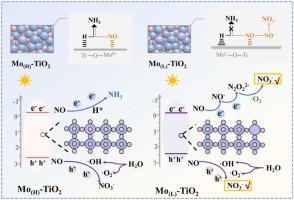TiO2中低价钼位作为活性氢阱促进NO高选择性光催化合成硝酸盐
IF 6.3
2区 材料科学
Q2 CHEMISTRY, PHYSICAL
引用次数: 0
摘要
利用NO光催化合成NO3-已受到广泛关注。但在此过程中产生的活性氢(H*)能够将NO和NO3-还原为氨,且还原值相对较低,从而导致活性和选择性降低。在此,我们通过构建Mo掺杂TiO2来开发H*陷阱策略,其中低价Mo4+作为H*陷阱来抑制H*的生成并阻碍氨的生成。Mo(L)-TiO2 (Mo掺杂低价Mo4+的TiO2)具有显著的NO3生成活性,产率为285.61 μmol·gcat-1·H -1,选择性接近100%,显著高于Mo(H)-TiO2 (Mo掺杂高价Mo6+的TiO2)。实验和理论分析表明,低价钼具有较强的氢吸附能,阻碍了H*的生成(H++e-→H*),使光生电子不再驱动氨合成反应。相反,光电子促进NO的活化,依次生成NO-和顺式n2o22 -中间体,这些中间体随后与•O2-反应生成NO3-。本研究提出了一种通过低价钼驱动活性氢阱策略来提高光催化NO转化效率和调节产物选择性的新方法。本文章由计算机程序翻译,如有差异,请以英文原文为准。

Low-valent molybdenum sites as active hydrogen traps in TiO2 for facilitating high-selectivity photocatalytic nitrate synthesis from NO
The photocatalytic utilization of NO to synthesize NO3- has received extensive attention. However, the active hydrogen (H*) species produced during the process are capable of reducing NO and NO3- to ammonia with a relatively lower value, thereby leading to a reduction in activity and selectivity. Herein, we developed the H* traps strategy by constructed Mo doping TiO2, where low-valence Mo4+ acts as an H* trap to inhibit the generation of H* and impede ammonia generation. Mo(L)-TiO2 (Mo doping TiO2 with low-valence Mo4+) exhibits remarkable NO3- generation activity with a yield of 285.61 μmol‧gcat−1‧h−1 and nearly 100 % selectivity, which is significantly higher than that of Mo(H)-TiO2 (Mo doping TiO2 with high-valence Mo6+). Experimental and theoretical analyses reveal that low-valent molybdenum has strong hydrogen adsorption energy, which hinders the generation of H* (H++e-→H*) and causes photogenerated electrons to no longer drive the ammonia synthesis reaction. Instead, photogenerated electrons facilitate the activation of NO to sequentially generate NO- and cis-N2O22- intermediates, and these intermediates subsequently react with •O2- to form NO3-. This research presents a novel approach for enhancing the efficiency of photocatalytic NO conversion and adjusting product selectivity via the low-valent molybdenum driven active hydrogen traps strategy.
求助全文
通过发布文献求助,成功后即可免费获取论文全文。
去求助
来源期刊

Journal of Alloys and Compounds
工程技术-材料科学:综合
CiteScore
11.10
自引率
14.50%
发文量
5146
审稿时长
67 days
期刊介绍:
The Journal of Alloys and Compounds is intended to serve as an international medium for the publication of work on solid materials comprising compounds as well as alloys. Its great strength lies in the diversity of discipline which it encompasses, drawing together results from materials science, solid-state chemistry and physics.
 求助内容:
求助内容: 应助结果提醒方式:
应助结果提醒方式:


